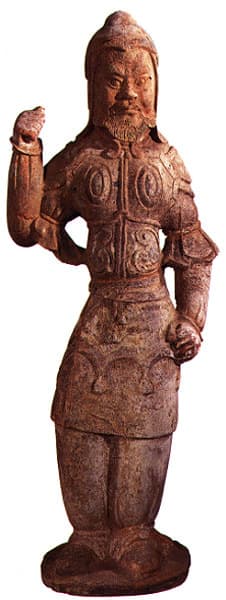Tang Terracotta Sculpture of a Military Officer, 618 CE - 907 CE
Terracotta
23
H.553
The T’ang Dynasty was an era of unrivalled wealth and luxury. The country was successfully reunified and the borders were expanded, pushing Chinese influence into new lands. Confucianism became a...
The T’ang Dynasty was an era of unrivalled wealth and luxury. The country was successfully reunified and the borders were expanded, pushing Chinese influence into new lands. Confucianism became a semi-religious instrument of the state; yet Buddhism continued to flourish, spreading into Korea and Japan. The arts reached new levels of sophistication. Poetry and literature flourished under the enlightened rulers. The Silk Road brought fortunes into China. Precious treasures were imported on the backs of camels from far away lands and bartered for Chinese silk, medicinal herbs, and pungent spices. T’ang China was a multicultural empire where foreign merchants from across Central Asia and the Middle East settled in the urban centers, foremost among them the thriving capital of Chang’an (modern X’ian), a bustling cosmopolitan center of over two million inhabitants. Foreign traders lived next to native artisans and both thrived. New ideas and exotic artistic forms followed alongside. The T’ang Dynasty was a cultural renaissance where many of the forms and objects we now associate with China were first created. Moreover, this period represents one of the greatest cultural outpourings in human history.
(spirit articles) were a prominent feature o Chinese mortuary pottery made for the nobility and distinguished men. Over time the subject matter changed to reflect current fashions,
interests and concerns. Clay figures of military generals, included in tombs sinc the Western Han period, are particularly good illustrations of thos permutations. Military successe ensured security and fostered expansiveness as maritime and overland trad routes, such as the Silk Road, extended the trading sphere from Japan to th Byzantine and Islamic empires, bringing foreign peoples to the capital. This cultural diversity is depicted in the costumes, facial features,
occupations, and pastimes of figures that began to embrace realis in form and detail unusual in Chinese art.
This sculpture of a military officer captures the vitalit of a gallant warrior as well as attests this flowering a cultural diversity. Foreigners were often depicted with more facial hair and prominent noses. This bearded warrior appears to combine Chinese and foreig attributes, accentuating the ferocity and tenacity of the soldier's spirit. The body is clad in heavy armor--the chest plates are divided into fou sections with decorative motifs and the shoulder plates cover the upper ar which is protected by a second layer of clothing tied above the chain mail o the forearm. In typical T'an fashion, the soft clothing and armor extend beyond the waist where it is cinche with a studded belt. The office wears ballooned pants drawn at the ankles over leather boots and sport protective headgear that is characterized by a protuberance on the top of th helmet. His arms gesture as if h were grasping weapons in both hands as he stands in an attentive ready-to-strik position.
This sculpture is a magnificent example of the T'an artisan's attempt to imbue the medium with the spirit and vitality of an actua person so that it could perform its duties to protect and guide the deceased i hospitable environments.
(spirit articles) were a prominent feature o Chinese mortuary pottery made for the nobility and distinguished men. Over time the subject matter changed to reflect current fashions,
interests and concerns. Clay figures of military generals, included in tombs sinc the Western Han period, are particularly good illustrations of thos permutations. Military successe ensured security and fostered expansiveness as maritime and overland trad routes, such as the Silk Road, extended the trading sphere from Japan to th Byzantine and Islamic empires, bringing foreign peoples to the capital. This cultural diversity is depicted in the costumes, facial features,
occupations, and pastimes of figures that began to embrace realis in form and detail unusual in Chinese art.
This sculpture of a military officer captures the vitalit of a gallant warrior as well as attests this flowering a cultural diversity. Foreigners were often depicted with more facial hair and prominent noses. This bearded warrior appears to combine Chinese and foreig attributes, accentuating the ferocity and tenacity of the soldier's spirit. The body is clad in heavy armor--the chest plates are divided into fou sections with decorative motifs and the shoulder plates cover the upper ar which is protected by a second layer of clothing tied above the chain mail o the forearm. In typical T'an fashion, the soft clothing and armor extend beyond the waist where it is cinche with a studded belt. The office wears ballooned pants drawn at the ankles over leather boots and sport protective headgear that is characterized by a protuberance on the top of th helmet. His arms gesture as if h were grasping weapons in both hands as he stands in an attentive ready-to-strik position.
This sculpture is a magnificent example of the T'an artisan's attempt to imbue the medium with the spirit and vitality of an actua person so that it could perform its duties to protect and guide the deceased i hospitable environments.
Literature
V20



